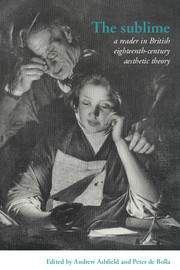Part I - The Longinian tradition
Published online by Cambridge University Press: 05 June 2012
Summary
Eighteenth-century readers of Longinus were particularly impressed by the style and verbal resonance of the text. A number of passages became almost conventional topoi for the display of a commentator's learning and appreciation, many of which were known in the fine English translations.
Longinus suggests that there are five sources of the sublime [Longinus], and these are much discussed and debated throughout the eighteenth century. See below part V in which Blair's comments represent one of the critical strands of this debate in which all but the first two sources are diminished as of real importance in the analytic of the sublime. There is, however, another strand to this discussion in which the rhetorical analysis of tropes and figures takes on far greater importance thereby creating an understanding of the sublime in terms of its discursive and figurative formation.
Another topos in the Longinian text for extensive commentary begins “So the space between Heaven and Earth” in section IX. This distinction in conjunction with images of terror leads Smith to cite Milton's sublimity:
There is a serious turn, an inborn Sedateness in the Mind, which renders Images of Terror grateful and engaging. Agreeable Sensations are not only produced by bright and lively Objects, but sometimes by such as are gloomy and solemn. It is not the blue Sky, the chearful Sun-shine, or the smiling Landscape, that give us all our Pleasure, since we are indebted for no little share of it to the silent Night, the distant howling Wilderness, the melancholy Grot, the dark Wood, and hanging Precipice.
- Type
- Chapter
- Information
- The SublimeA Reader in British Eighteenth-Century Aesthetic Theory, pp. 17 - 21Publisher: Cambridge University PressPrint publication year: 1996

